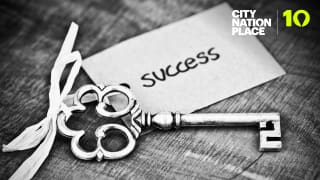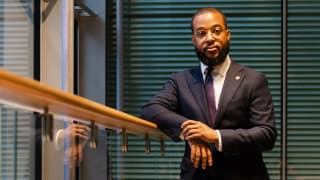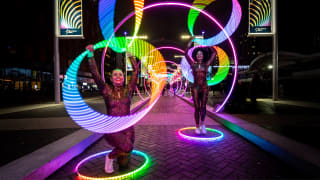Creating the park of the future
In recent years, there have been many placemaking projects to reclaim disused areas to transform them into green public spaces, but none have the audacity of Raleigh’s Dorothea Dix Park. The 308-acre property is the largest downtown park project in the USA since the 1800s, but ensuring that the park becomes an asset for the entire community as well as an attractive new asset for the city is the key to the success of the project. We caught up with Sean Malone, President & CEO, of Dorothea Dix Park Conservancy, to discover how this has shaped their strategy.
The key to successful placemaking
Thank you for agreeing to speak with us, Sean. Dorothea Dix Park is a fantastic project, but it’s interesting to see how many stakeholders are working together to drive the enterprise. Is this public-private partnership the key to the success of the park?
The most important parks and public spaces in America rely on public-private partnerships to make them vibrant and successful. The effort to create Dorothea Dix Park is one of those best-practice public-private partnerships between the City of Raleigh and Dorothea Dix Park Conservancy. The City of Raleigh owns and operates Dorothea Dix Park and is lead the planning and implementation efforts. The Conservancy is a community-led nonprofit that exists to support the City in its efforts, serve as its philanthropic and community engagement partner, and help ensure the creation and long-term success of Dorothea Dix Park as a place for everyone – a transformative public space for community, health, and celebration that will meaningfully enrich our quality of life.
The wonderful staff and board of the Conservancy is incredibly proud to partner with and be of service to the City of Raleigh. The team at the City of Raleigh has been so impressive in the work they do - planning, and community engagement, and implementation, and programs and event, and so much more. The project director for Dix Park, Kate Pearce with the City of Raleigh, talks about the idea that we’re all "building the plane while we fly it” on this project - and the City team is as great at piloting as they are at building.
As we talk today, anytime I say “we,” please know that “we” means the City and the Conservancy and the entire community that is working together to make this project possible.
When you started the project originally then, was there a single, overarching vision that helped kickstart the work? An idea that helped to align the different partners to a common goal?
In the United States, what Raleigh has in an unparalleled opportunity. This amount of land right in the downtown area that’s publicly owned by the city and dedicated to be a park? It hasn’t happened since the mid-1800s. Not since they were creating Central Park and the other Great American Parks. And to be technical, even then, the most audacious thing about Central Park was that at the time, it wasn’t central to anything at all!
The last time anyone got to do this for an urban core was 150-175 years ago, and the next time anyone in the US is going to get to do this is never. The land simply doesn’t exist – it’s physically impossible. Our community is taking that opportunity really seriously and trying to create something that is a transformative public space. One that belongs to everyone, and everyone feels belongs to them. The community is geared up and ready to do it. But that said, we’re geared up knowing that there are always huge headwinds when you talk about bold financial investments. Aligning the investment we make with what we’re trying to do, what its focus is, what is its calibre of design can be, what makes it special. And, importantly, embracing and conveying the truth that creating something special does NOT inherently diminish other things.
It’s an amazing opportunity. We’ve seen increasingly that places are getting creative with how they can repurpose land pockets to engage their communities and provide green spaces, but to be able to have that level of ambition? It’s unheard of.
Exactly. I think there are basically three categories of urban parks being built in America right now. There are big parks (even bigger than Dorothea Dix Park’s 308 acres) being created on the outskirts of the cities. An amazing approach in urban cores that gets lots of well-deserved attention is adaptive reuse of existing infrastructure – turning the Highline into a park for example. How we adapt unconventional and sometimes small areas into a public space is wonderful, but it doesn’t have that grandiosity of Central Park. It’s not boundless. And then there’s the third category – and that’s Dix Park. It’s kind of its own category in the U.S.
Connecting placemaking to policy
It’s interesting that you’ve mentioned the different categories of parks being built – over recent years, there have been several cases where park renovation has resulted in displacing the local community as the area becomes ‘trendy’. The New York High Line that you just mentioned is something of a poster child for people who are accusing park projects of gentrification. How are you working to avoid this?
There’s a lot to that, and it’s a question that’s high on our minds. We will certainly have some of the challenges you mention – but potentially fewer than most projects on this scale, and that has to do with the geography of the borders of this land. It’s slightly over stating this, but the land is essentially a triangle with two long edges and one shorter edge. One edge is a major throughway – we’re looking at how to create a natural edge inside the park, but it’s a major road on the other side. The other long edge is owned entirely by the state of North Carolina. Some of the land is owned by NC State University, some by the Department of Agriculture. I expect that some of that currently-unoccupied land will be developed into a strong edge to the park. But there’s no community there to be displaced.
The third edge is the shortest edge. Some of that is a State Farmers market, which will stay and grow and serve the public (and farmers) even better than it already does. And then there’s a community right there that is a naturally occurring affordable housing area, and that’s the area we’re everyone is thinking the most about displacement.
We live in a market economy. If you create something wonderful, the property values go up. The answer to that can’t be to not do anything wonderful. So the answer has to be through policy – through zoning and what is being built by that edge and throughout the community. And it has to be on a macro-level. The City can’t make decision based on the desires of a single resident, but you also can’t say “So what?” either. The City has to look at what’s happening at a policy level to ensure that people are able to afford to live in the City of Raleigh. And, fortunately, this is a forward-thinking and empathetic City that’s really taking this issue seriously.
So what’s happening on a policy level?
Part of the proof that our elected officials are embracing this is that there will be a Quality of Life bond on the ballot – an initiative to bring in major bond funding for Dorothea Dix Park AND housing affordability AND existing parks and greenways. Those who are proponents of each of those buckets will be working hard to support each other, not to jockey against each other. It’s stronger if we work together. Excitement about the park, for example, drives more interest in affordable housing.
It’s something that we’re just starting to see nationally – green spaces are part of the solution. A key element of the housing solution is density. And part of what makes dense spaces liveable is natural green areas – the ability to walk to boundless green space in the middle of the urban core, and just breathe. It’s not frosting. It’s not a luxury. You can’t tack it on at the end. It’s part of the solution.
A park for everyone, built by everyone
I noticed that your tagline is ‘A park for everyone, built by everyone,’ and it’s already clear to see that having solid engagement from your citizens is a core focus for you, but how have you actually built this into your strategy?
I think in a few different ways. We completed development of the master plan in 2019, so now we’re in the phase of getting people behind implementing it. Up until the master plan, all our focus was on creating that plan – discovering what people want, what they needed. In total, 65,000 citizens participated in the master planning. We had big community meetings, and they were more diverse than most planning meetings, but they were still reflective of what you often see with community meetings – an over-representation of wealthy, older, white homeowners. So in addition to these meetings, we did a lot of programming at the park and using that to engage people in the planning. We did a lot of mobile outreach, going out to communities and festivals. We did a significant amount of online engagement too. So that’s how we reached that really significant number of people, and then we tried to work with leaders in various different geographic, demographic, socio-economic, and other communities to get as many perspectives involved as possible.
Our next step is a little more philosophical. We’re in the process of evolving a committee that will be the voice of the community in guiding the next phases, but also to be the voice of the park in the community. The idea is to ensure we have a committee that is intentionally representative of our community – demographically, geographically, and in terms of expertise and profession. They would be the voice of the community in guiding the next phases of the project. Like many places in the South, we have a complex racial history, and it’s critical to create a space that belongs to everyone.
The site of the park was a mental health hospital for over 150 year. For 150 years before that, it was a plantation. There’s a complex legacy here – one that we face head on. Now we have an opportunity to write our own future. There’s no historical “who’s park is this?,” because it wasn’t a park before. So, from the beginning, we can say “This park belongs to all of us.” That’s sometimes incredibly well-received and sometimes taken with scepticism because underrepresented citizens hear a lot of empty promises but then there’s no follow-up. It’s our job to make sure that “A park for everyone, built by everyone” is more than just a tag line. It is, and has to be, a core value.
Demonstrating the ROI of a placemaking project
There are a lot of stakeholders working together on this clearly! And ranging all the way from non-profits to private sector to the community themselves. How has it been getting so many stakeholders to engage and work together?
It’s hard work; I don’t want to be overly optimistic about it. But it’s clear that stakeholders are coming together with amazingly good intentions. Sometimes there’s a lack of trust to start, but that lack of trust is well earned. It’s important for those of us who are not disenfranchised to be aware of the huge number of things we don’t know, and the huge number of experiences we haven’t had. It’s easy for me to say that though, so we really have to walk that walk. There are frustrations, but for good reason, and they tend to be broader, around a quality of life for everyone. And not just using that as jargon while still not meeting people’s core needs.
We also need to make sure that those realities don’t derail a rare opportunity. If this project became too incremental with us designing something less meaningful to save a little money, or slowly developing small components of the space instead of working to create a transformative space in a 7-10 year period, then we’ve lost the opportunity. A project this important, ambitious, and meaningful just won’t happen that way. The community has talked about this project as a “moon shot.” And a moon shot has to be a moon shot.
It’s also not a question of “Do I spend money on Dix Park or on housing affordability?” Most people start with the assumption that there’s a fixed amount of pie, and every bite of pie that someone else gets is pie they don’t get. And the reality of the research is that a signature park like this creates way more additional pie than you could possibly spend on the park itself. Nationally, every dollar spent on an urban park generates $20.84 in economic impact.
That’s a staggering figure.
It really is! And that return on investment is even larger (much larger) when you look at signature/destination parks like this space will be. On top of the ROI for all urban parks, the economic impact from tourism is enormous, and that’s nothing compared to the impact a project like this has on jobs tax revenue and people’s livelihoods. We’ve heard directly from CEOs who have headquarters here saying that they were wondering about moving their headquarters but now they don’t have to because of the impact a space like this has on talent attraction and retention. And we hear the same from companies that are looking to move their business here.
It’s a long-term investment – it’s like being given the opportunity to go back thirty years and buy Apple stock, with the advantage of knowing where Apple is going to go. And if you can do that and pay your daily needs (and Raleigh clearly can)? Then you do it. The scale of what can be accomplished to enrich people’s lives is simply extraordinary.
Communicating your project
I know that it’s early days for the project, but is there anything that you would have done differently with hindsight? Or is there a piece of information that you wish you could have known a few years ago?
A million things. The one that I’m still working to get my head around – and I’m still not doing it right – is a messaging and timing issue. Over and over again we’ve found ourselves in a position where we felt like we were just a month or two away from more-perfect, ready-to-go information – that if we just wait a little longer, that next key decision would be made and we could go out with the full picture and the most persuasive message. And though that was true, we were (over and over again) 3-6 months past when we should have been out there with the message/piece/outreach/idea in question.
It’s a hard problem to fix. We need to get our messages out – and we need to do this even if they’re not perfect. But we also need to be sensitive to our partners and stakeholders; we need to be proactive with our messaging and communications without getting ahead of or creating challenges for our partners and stakeholders.
I can’t say exactly what I would have done differently, I just know that we kept making different versions of the same mistake. It’s certainly not dire; nothing has been derailed and there’s great excitement for the park. But there is a real challenge when it comes to the communications cadence and clearance for getting the message right AND getting the message out. It’s learning process though – and everyone involved is committed to figuring out how to thread this needle to keep the project moving forward successfully.
Thank you for speaking with us, Sean.
Join Sean and the City Nation Place team at the Americas conference this May in Toronto. See our Agenda updates and also our How to Book page for more details.










